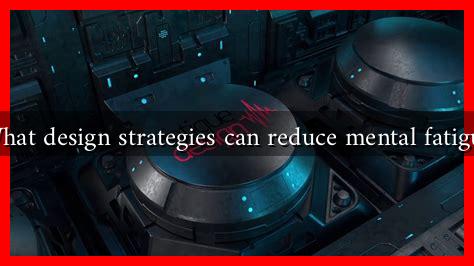-
Table of Contents
What Design Strategies Can Reduce Mental Fatigue?
Mental fatigue is an increasingly prevalent issue in our fast-paced, technology-driven world. It can lead to decreased productivity, impaired decision-making, and even burnout. Fortunately, design strategies can play a crucial role in mitigating mental fatigue. This article explores various design approaches that can help create environments and experiences that promote mental clarity and reduce fatigue.
Understanding Mental Fatigue
Mental fatigue occurs when cognitive resources are depleted, often due to prolonged periods of concentration or stress. According to a study published in the journal *Cognitive, Affective, & Behavioral Neuroscience*, mental fatigue can impair cognitive performance and lead to a decline in motivation. Recognizing the signs of mental fatigue is essential for implementing effective design strategies.
Design Strategies to Combat Mental Fatigue
Here are several design strategies that can help reduce mental fatigue in various environments, from workplaces to educational settings:
- Ergonomic Design: Ergonomics focuses on creating spaces that fit the needs of users. Ergonomic furniture, such as adjustable chairs and desks, can help reduce physical strain, which in turn minimizes mental fatigue. A study by the Occupational Safety and Health Administration (OSHA) found that ergonomic interventions can lead to a 25% reduction in fatigue-related complaints.
- Natural Light and Biophilic Design: Incorporating natural light into design can significantly enhance mood and energy levels. Biophilic design, which integrates natural elements into built environments, has been shown to reduce stress and improve cognitive function. A study published in the *Journal of Environmental Psychology* found that exposure to natural elements can lead to a 15% increase in productivity.
- Color Psychology: The colors used in a space can influence mood and cognitive performance. For instance, blue hues are often associated with calmness and focus, while warmer colors like red can stimulate energy. A well-thought-out color palette can create an environment that fosters concentration and reduces feelings of fatigue.
- Clutter-Free Spaces: A cluttered environment can overwhelm the mind and lead to increased stress. Designing spaces with minimalism in mind can help create a sense of order and clarity. Research from Princeton University found that physical clutter can negatively impact our ability to focus and process information.
- Flexible Workspaces: Providing options for different work environments can cater to various tasks and personal preferences. For example, quiet zones for focused work and collaborative spaces for teamwork can help individuals switch between modes of thinking, reducing mental fatigue.
Case Studies and Real-World Examples
Several organizations have successfully implemented design strategies to combat mental fatigue:
- Google: Google’s offices are designed with open spaces, natural light, and areas for relaxation. This approach has been linked to increased employee satisfaction and productivity, demonstrating the effectiveness of thoughtful design.
- Steelcase: The furniture company Steelcase conducted research showing that workplaces designed with employee well-being in mind can lead to a 12% increase in productivity. Their designs focus on ergonomics, flexibility, and access to natural light.
- University of Melbourne: The university redesigned its library to include more natural light and comfortable seating. As a result, student satisfaction increased, and reports of mental fatigue decreased significantly.
Conclusion
Reducing mental fatigue is essential for enhancing productivity and overall well-being. By implementing effective design strategies such as ergonomic furniture, biophilic elements, thoughtful color choices, clutter-free environments, and flexible workspaces, organizations can create spaces that promote mental clarity and reduce fatigue. As we continue to navigate a world filled with distractions and demands, prioritizing design that supports mental health will be crucial for fostering a more productive and engaged society.
For further reading on the impact of design on mental health, consider exploring resources from the Harvard Business Review.


